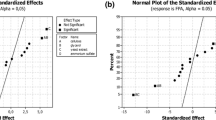Summary
Of the eighteen different carbon sources, solka floc was optimal for the induction of cellulases by the thermophilic fungusThielavia terrestris. The temperature optimum for growth was between 44–52°C. The effect of initial and controlled pH on fungal growth and cellulase production was investigated and the results obtained showed that the maximum volumetric productivity (6.07 I.U./1 per h) of filter paper activity was achieved when the pH was controlled at 4.5–5.0.
Similar content being viewed by others
References
Canevascini, G., M.R. Coudray, J.P. Ray, R.J.G. Southgate and H. Muir. 1979. Induction and catabolite repression of cellulase synthesis in the thermophilic fungusSporotrichum thermophile. J. Gen. Microbiol. 110: 291–303.
Coutts, A.D. and R.E. Smith. 1976. Factors influencing the production of cellulase bySporotrichum thermophile. Appl. Environ. Microbiol. 31: 819–825.
Creese, E. 1983. Cellulases fromSporotrichum thermophile grown on wheat straw. M.E.Sc. Thesis. The University of Western Ontario, London, Ontario, Canada.
Eriksen, J. and J. Goksoyr. 1976. The effect of temperature on growth and cellulase (β-1-4-endoglucanase) production in the compost fungusChaetomium thermophile var.dissitum. Arch. Microbiol. 110: 233–238.
Fennington, G., D. Neubauer and F. Stutzenberger. 1983. Adenosine 3′,5′-cyclic monophosphate levels inThermonospora curvata during cellulase biosynthesis. Biotechnol. Bioeng. 25: 2271–2276.
Folan, M.A. and M.P. Coughlan. 1978. The cellulase complex in the culture filtrate of the thermophilic fungusTalaromyces emersonii. Int. J. Biochem. 9: 717–722.
Hagerdal, B., J.D. Ferchak and E.K. Pye. 1978. Cellulolytic enzyme system ofThermoactinomyces sp. grown on microcrystalline cellulose. Appl. Environ. Microbiol. 36: 606–612.
Hagerdal, B., J.D. Ferchak and E.K. Pye. 1980. Saccharification of cellulose by the enzyme system ofThermonospora sp. 1. Stability of cellulolytic activity with respect to time, temperature and pH. Biotechnol. Bioeng. 22: 1515–1526.
Linko, M. 1977. An evaluation of enzymatic hydrolysis of cellulosic materials. Adv. Biochem. Eng. 5: 25–48.
Lowry, O.H., N.J. Rosebrough, A.L. Farr and R.J. Randall. 1951. Protein measurement with the Folin-Phenol reagent. J. Biol. Chem. 193: 265–275.
Merchant, R.F. 1984. Thermostable cellulases and xylanases fromThielavia terrestris. M.E.Sc. Thesis. The University of Western Ontario, London, Ontario Canada.
Margaritis, A. and R. Merchant. 1984. Production and thermal stability characteristics of cellulase and xylanase enzymes fromThielavia terrestris. Biotechnol. Bioeng. Symp. Series. No. 13: 299–314.
Margaritis, A. and Merchant, R. 1986. Thermostable cellulases from thermophilic microorganisms. CRC Crit. Rev. Biotechnol., in the press.
Margaritis, A., R. Merchant and M. Yaguchi. 1983. Xylanase, CM-cellulase and avicelase production by the thermophilic fungusSporotrichum thermophile. Biotechnol. Lett. 5: 265–270.
Meyer, H. and A.E. Humphrey. 1982. Cellulase production by a wild and new mutant strain ofThermonospora sp. Biotechnol. Bioeng. 24: 1901–1904.
Moloney, A.P., P.J. Considine and M.P. Coughlan. 1983. Cellulose hydrolysis by the cellulase produced byTalaromyces emersonii when grown on different inducing substrates. Biotechnol. Bioeng. 25: 1169–1173.
Montenecourt, B.S. and D.E. Eveleigh. 1977. Preparation of mutants ofTrichoderma reesei with enhanced cellulase production. Appl. Environ. Microbiol. 34: 777–782.
Moreira, A.F. 1977. Optimization studies on the cellulose fermentation by aThermoactinomyces vulgaris strain. Ph.D. Thesis. The University of Pennsylvania.
Saddler, J.N. and M.K.H. Chan. 1982. Optimization ofClostridium thermocellum growth on cellulose and pretreated wood substrates. Eur. J. Appl. Microbiol. Biotechnol. 16: 99–104.
Sen, S., T.K. Abraham and S.L. Chakrabarty. 1981. Cellulolytic activity ofMyceliopthora thermophila D-14. Curr. Sci. 50: 598–600.
Skinner, W.A. and F. Tokuyama. 1978. Cellulase by a thermophilicThielavia terrestris. U.S. Patent 4,081,328. March 28.
Sternberg, D. and S. Dorval. 1979. Cellulase production and ammonia metabolism inTrichoderma reesei on high levels of cellulose. Biotechnol. Bioeng. 21: 181–191.
Vandamme, E.J., J.M. Logghe and A.M. Geeraerts. 1982. Cellulase activity of a thermophilicAspergillus fumigatus (Fresenius) strain. J. Chem. Tech. Biotechnol. 32: 968–974.
Yoshioka, H. and S. Hayashida. 1980. Purification and properties of β-glucosidase fromHumicola insolens YH8. Agr. Biol. Chem. 44: 1729–1735.
Yoshioka, H., S.I. Anraku and S. Hayashida. 1982. Purification and properties of a novel type of CMCase fromHumicola grisea varthermoidea YH 78. Agr. Biol. Chem. 46: 75–82.
Zeikus, J.G. 1979. Thermophilic bacteria: Ecology, physiology and technology. Enzyme Microb. Technol. 1: 243–252.
Author information
Authors and Affiliations
Rights and permissions
About this article
Cite this article
Margaritis, A., Merchant, R.F. Optimization of fermentation conditions for thermostable cellulase production byThielavia terrestris . Journal of Industrial Microbiology 1, 149–156 (1986). https://doi.org/10.1007/BF01569266
Received:
Revised:
Accepted:
Issue Date:
DOI: https://doi.org/10.1007/BF01569266




